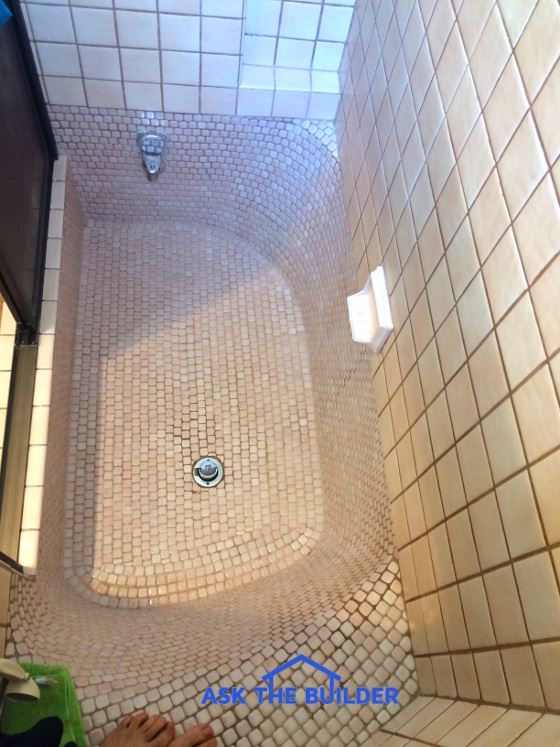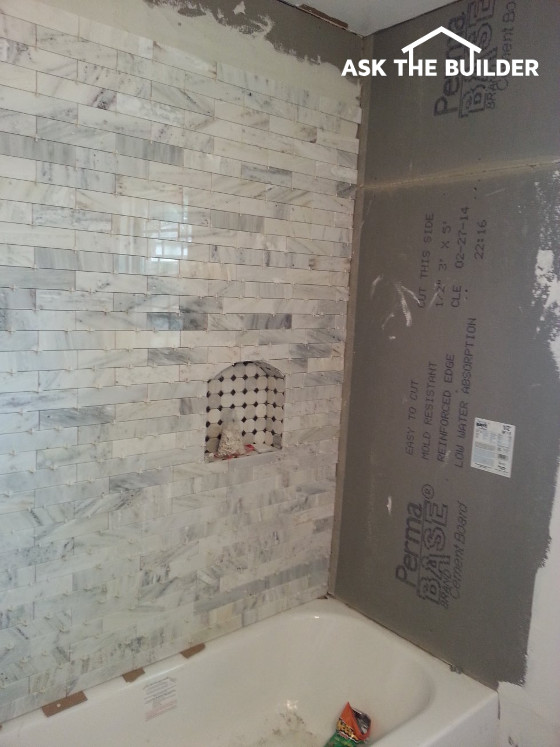Waterproofing Tile Shower and Tub

Here's the amazing sunken tub with the mosaic tile. You have no idea how hard it is to build one of these that looks this good! Copyright 2017 Tim Carter
Your new home may have a ceramic or even cultured marble tub or shower surround. When done right, they can look splendid for years. Surely you have seen a well-built ceramic tile or marble tub and shower that has stood the test of time as you have walked through an older home. For that tile and marble to last, the builders and installers made sure water did not seep behind the finish materials to cause wood rot.
What are some tips to keep the water in the tub or shower?
Your builder and his subcontractors can do the same thing in your new home. Fortunately, we have materials today that make this task not only easy, but the results are bulletproof. When done right, you can rest assured all water will eventually stay in the tub and shower where it belongs.
Virtually every tub and shower pan, even shower pans made with membranes, have a lip that folds up at the edge of the fixture. This lip is hidden by the substrate that is under the finished wall material. The purpose of the lip is to redirect water back towards the center of the fixture. A roofer would look at this lip and immediately recognize it as a flashing not much different from the ones he uses to redirect water back onto shingles so it can continue down the roof.
Need help with your bathroom remodeling? CLICK or TAP HERE to get FREE quotes from local companies that can handle your remodeling project.
What is the best location for installing a water resistant membrane?
The best defense your builder can employ is the application of a water resistant membrane on the stud walls that lap down over, not behind, this lip. This membrane can be simple asphalt-saturated felt paper, newer waterproof underlayment membranes or traditional plastic sheeting. If any water gets past the tile, grout and the cement board or water resistant gypsum board under the tile, it is blocked and redirected to the tub or shower by these thin, yet powerful fabrics.
The best part is that it takes perhaps three or five minutes to install these membranes. Often the material is scrap that might be lying around the jobsite. What better way to lower the input into landfills and to permanently waterproof one small part of your new home?
What is cement board and should you use it around tubs?
The next step to stopping water from even getting to this membrane is to take a few simple steps while installing the substrate on the walls. I prefer to use cement board under ceramic tile and cultured marble for many reasons. First and foremost, it is 100 percent waterproof. If the cement board gets wet and stays wet for years for some reason, it will not fall apart. You can't say that about many of the gypsum-based products that are currently on the market.

During the remodeling. The cement backer board is visible on the right.
As this cement board is installed, I feel it is a good idea to pay attention to where the material contacts the tub or shower and where it touches up against another piece of cement board. For example, I try to create a crisp one-quarter inch gap between the cement board and the top of the tub or shower fixture. I also try to create these same, or slightly smaller gaps in the corners where one piece of cement board intersects another. Gaps are also created if there are horizontal seams where cement board is stacked upon one another.
How do you fill the gaps around the cement board?
Once the cement board is securely fastened to the walls, these gaps are filled with 100 percent silicone caulk. I suggest you leave several small gaps, perhaps one-half inch long, in the caulking bead at the top of the tub. Do this on every wall. These gaps are drainage holes that allow water to get back towards the tub or shower in the event water somehow gets to the membrane behind the cement board.
These steps are easy to do and should not add any significant cost to your new home. Even if it does cost an extra $50, it is well worth the price. Imagine how costly it might be to rebuild the shower 10 or 15 years from now. I can tell you, it will be 20 or even 30 times the cost to make these small modifications now.
Column NH053
3 Responses to Waterproofing Tile Shower and Tub